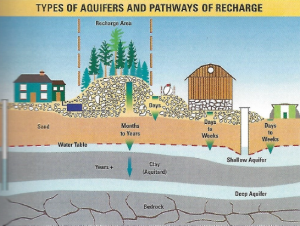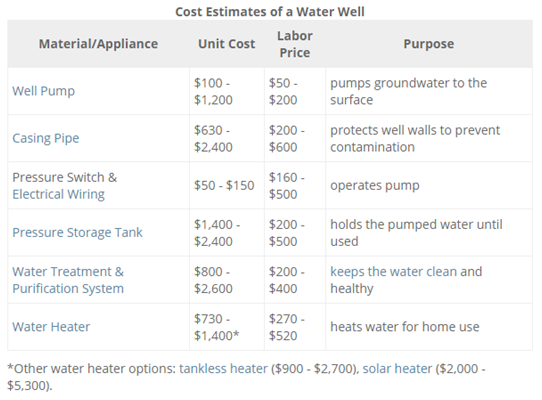By definition, a well is an excavation or structure created in the ground by digging, driving, or drilling to access liquid resources, usually water. A water well is a hole drilled, dug or bored into an aquifer from which groundwater can be drawn.

What are aquifers?
An aquifer is an underground layer of water-bearing permeable rock, rock fractures or unconsolidated materials (gravel, sand, or silt). Aquifers occur from near surface to deeper than 30,000 feet. Those closer to the surface are not only more likely to be used for water supply and irrigation, but are also more likely to be topped up by the local rainfall.
An aquitard is a geological formation that prevents the significant flow of water. Common examples include clay layers or tight deposits of shale. Unconfined, or water table aquifers, are usually the shallowest. The top of an unconfined aquifer is the water table. Water table aquifers are often encountered between 5 and 50 feet deep.
Confined, or artesian aquifers, are covered by an aquitard — a confining layer of lower permeability soil such as clay. An artesian aquifer is a confined aquifer containing groundwater under positive pressure. This causes the water level in the well to rise to a point where hydrostatic equilibrium has been reached. This is referred to as an artesian well. In essence, an artesian well is formed because of pressure, rather than some of the other ways that a well can be formed, including digging and drilling.
How are water wells made?
The structure can be lined with brick or stone as the excavation proceeds. A more modern approach uses pre-cast reinforced concrete well rings that are lowered into the hole. Driven wells can be created in unconsolidated material with a well hole structure, which consists of a hardened drive point and a screen of perforated pipe, after which a pump is installed to collect the water. Deeper wells can be excavated by hand drilling methods or machine drilling, using a bit in a borehole. Drilled wells are usually cased with a factory-made pipe composed of steel or plastic. Drilled wells can access water at much greater depths than dug wells.
Two broad classes of wells are shallow or unconfined wells completed within the uppermost saturated aquifer at that location, and deep or confined wells, sunk through an impermeable stratum into an aquifer beneath. Well water typically contains more minerals in solution than surface water and may require treatment before being potable.
The following components are common to all wells:
- The inlet — which allows groundwater to enter the well
- The hole stabilizer — which prevents the formation from collapsing into the well
- Sanitary protection — including grout in the annular space around the casing, seals between concrete tiles or at the point of entry of water and electrical lines
- The pumping system — including the pump itself, along with electrical line
Note: a large diameter well is usually shallow and a small diameter well is deep.



How is groundwater extracted from the well?
The two most common types of pump are shallow well and deep well.
Shallow well pumps work by suction lift but the lift is limited to about 25 feet. These pumps sit at the ground surface adjacent to the well. They work by creating a vacuum in the pipe and atmospheric pressure forces the water up the pipe. A foot valve on the bottom of the drop pipe keeps the pipe and the pump full of water. Common shallow well pumps include:
- Reciprocating (piston) pump
- Centrifugal pump
- Centrifugal-jet pump



Deep well pumps work in several ways. Reciprocating (piston) pumps work the same way as a hand pump. A motor sitting above the well moves a piston up and down inside a pipe in the well casing. On the upstroke, water is pulled into the pipe. A foot valve at the foot of the pipe prevents water from flowing out of the pipe on the downstroke.
The size of the pump required depends on the capacity of the well, the demand rate for water, and the height of lift.
Groundwater
For thousands of years, people have used wells to tap the abundant supply of fresh water in the earth. There are good sources of information in your area and for wells on your property, including:
- Water well records on file with provincial agencies
- Maps and reports on groundwater published by provincial agencies, and in some cases, municipalities also have information on groundwater availability and quality
- Local licensed water well contractors
- Hydrogeologists, scientists and engineers who study groundwater

Groundwater quality
Both natural processes and human activity can impact groundwater. The difference is that natural processes can either improve groundwater quality or degrade its aesthetic qualities. Human activity, for the most part, contaminates groundwater. With care, the impact of human activities can be reduced.
Water well quality may change due to the seasonal effects of snowmelt and rainfall, or if the depth of the well’s aquifer changes.
Handling of the pump or water lines can introduce bacteria into the well. Chlorine is used to kill bacteria in a well, pump and distribution system. Generally speaking, the goal is to attain three consecutive “negative” water test results. A negative result is 0 for E. Coli and 0 for Total Coliform (T.C.).
There are two methods of chlorination. Shock chlorination (refer to tables 1 and 2 below) involves adding a large amount of chlorine to the water in the well and pumping it through the system. The chlorinated water is left in the system long enough to ensure complete disinfection. Continuous chlorination involves the continuous addition of low levels of chlorine to a water supply. Most municipal water supplies have continuous chlorination systems.
For shock chlorination, unscented liquid laundry bleach is the most common source of chlorine. Continuous chlorination usually involves the use of an electric hypochlorite dosing pump that adds a small amount of chlorine whenever the well pump runs.
Some private well systems require continuous chlorination. Your local health unit or reputable water conditioning company can advise on appropriate treatments for your specific problem.
Note: Chlorine can provide protection against most bacteria but some dangerous microbes are resistant or immune to chlorine. A safe water source and properly functioning well are your best protection. Chlorine provides extra insurance.
All wells should be tested at least three times per year. You may wish to test for bacteria more frequently if you’ve had a history of water quality problems or have a high-risk well. Check with your local public health unit as in most cases, the test is provided free of charge.


Well Maintenance Checklist
| ·Know where your well is located. Extend the casing above ground, if buried
·Watch for changes in the taste, odour and colour of the water ·Have a sample tested for bacteria at least 3 times per year ·Sample for other chemicals if you have concerns ·Test for nitrate-nitrogen every year ·Disinfect the well with chlorine after doing any work on the inside of the well or after maintaining pumping equipment ·Inspect the cover or sanitary seal for cracks and holes. Ensure the cover is securely in place and watertight ·If you have lightning rod protection, do not ground the system to your drilled well casing. Use a separate lightning rod |
·Inspect the inside of the well at least once per year, preferably early Spring after the snow melts
·Check the condition of the well vents to ensure they are unobstructed and the vent is screened to prevent the entry of vermin into the well ·Watch for settling of the ground around the outside of the well casing ·Mound up the ground around the outside of the well with clean earth to direct surface water drainage away from the well ·Keep potential contamination sources away from the top of the well ·Maintain a permanent grassed buffer at least 10 feet around the well ·When a well is no longer in use, plug and seal it properly |
Final Thoughts on Water Wells
Anyone in the business of constructing wells must have a well contractor’s license. The Ontario Ministry of the Environment licenses water well contractors and well technicians for drilling, boring, digging and pump installation.
Within two weeks of completing a new well, the person who constructed the well must give the owner a copy of the Water Well Record. The person who constructed the well must also give a copy to the Ontario Ministry of Environment.
Before purchasing rural property, it’s a good idea to check the Water Well Records on file with the provincial agencies and ask for water quality results.
To find out if a record exists for wells on your property in Ontario, call 1-888-396-WELL (9355). For all other Canadian provinces, click here to access water well records.

How much does it cost to install a water well?
The average boring/drilling cost for a water well is anywhere between $15-25 per foot of depth (or $25-65 per foot for a complete installation). Below are the costs of the individual components (and labour) for the well installation.
Are there costs associated with the maintenance of a water well?
No real costs are associated with the maintenance of the well (as you are doing most of the work yourself) as long as there is no contamination to the water. That being said, it is recommended that you have the well inspected by a licensed or certified water well systems professional every one to two years. The cost of the inspection is anywhere from $300-500.
Source: Agriculture and Agri-Food Canada, Water Wells, Revised Edition, 2003

